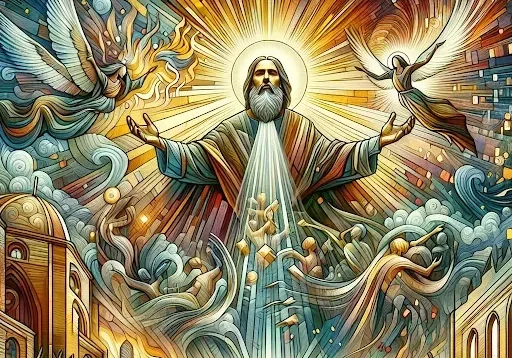The 7-Year Tribulation

SHARE
With all the grim events happening across the planet, it’s quite expected that many come up with dystopic images of the future of humankind. There is this impossibly perturbing idea of the “End Times”, or for Christians, “The Seven-Year Tribulation.”
Whatever it is called, it’s no wonder why many people think that we’re closing in on the end of the world. The pandemic coupled with severe natural disasters right and left can produce the worst of theories.
Indeed, these could just be the perfect breeding ground for Endtime speculations.
Still, there is this one big idea of the “Seven-Year Tribulation” that unsettles a lot of people. What’s the story behind it and what does it say about the world as we know it?
Let’s find out in this article.
What is “The Tribulation”?
Photo from express.co.uk
Before we dive into the whole idea of The Tribulation, let’s first try to understand some concepts.
Tribulation, in the English language, is defined as “a state of great suffering of body or mind.” That already sounds terrifying as it is, but there’s more.
In Christianity, there is what they call eschatology. This is the part of theology that is concerned with “the final events,” or the “last things” in the world, or humankind. When you hear about it, you will most likely pick up things like the Second Coming of Jesus Christ, the Last Judgment, or the culmination of God’s purpose. Basically, it’s the Christian doctrine pointing to the end of the world.
And you are also likely to hear about The Rapture. It is believed that the Rapture is the first event or beginning of the Second Coming, where Christian believers, or the Church, will ascend to heaven to meet Jesus, and the nonbelievers stay behind to deal with the tribulations.
In this case, many argue that the Church will be saved from the Tribulation.
But, in this context, what is “The Tribulation”?
The Tribulation is a specific period mentioned in the last book of the Bible: the Book of Revelations. Christians believe it to be a seven-year period wherein God’s wrath will pour onto the world before Jesus returns.
This is the time when God finishes his discipline for Israel (God’s people) and gives judgment to the unbelieving world.
Biblical References
As a Christian doctrine, the bases came from and are supported wholly by Bible scriptures. Like many other doctrines, there are many different interpretations that one can find.
Still, this particular concept of Tribulation has one, common reference. Specifically, it is found in Daniel 9:24-27, which talks about the prophecy of 70 sevens of years, or 70 weeks (Daniel 9:25, 26):
“Seventy ‘sevens’ are decreed for your people and your holy city to finish transgression, to put an end to sin, to atone for wickedness, to bring in everlasting righteousness, to seal up vision and prophecy, and to anoint the Most Holy Place.
The Tribulation goes by many names across the scriptures. It’s also called the Day of the Lord (Isaiah 2:12), Day of the Vengeance of God (Isaiah 34:8), or time of trouble (Daniel 12:1), and many others.
The names may vary; the bible passages may be extensively profound, but the essence remains: the Tribulation, in layman’s terms, fundamentally translates to the end times.
The Tribulation Period Highlights & Timeline
Another thing that may get confusing is the technical understanding of the Tribulation timeline.
First, let’s get the confusion out of the way. The scripture saying 70 weeks is not necessarily how we count our weeks. The 70 weeks in Daniel’s prophecy are in weeks of years. It literally translates to “70 sevens,” wherein a week is considered 7 years (Genesis 29:27).
Put simply: 1 week = 7 years; 70 weeks = 490 years
In Daniel 9:25 and 26, he was told that the Messiah will be cut off (death of Christ) after “seven sevens” for the rebuilding of Jerusalem, and “sixty-two sevens” until Jesus is crucified.
That is: 7 weeks (49 years) + 62 weeks (434 years) = 69 weeks (483 years)
But, remember we’re talking about the fulfillment of 70 weeks — meaning there’s one more week, or 7 years, that’s left to be fulfilled (490 years – 483 years = 7 years).
This final seven-year period is what is known as the Tribulation Period.
Here is a diagram to better illustrate:
As seen on the timeline, the Seven-Year Tribulation is split into two, halved by the Abomination of Desolation (Matthew 24:15), also described as the reign of the “beast” (Revelation 13). Others call him the Antichrist (1 John 4:3), or “the man of Lawlessness” (2 Thessalonians 2:3-4).
Some highlights of the period include him, the one Jesus calls an abomination that causes desolation, to confirm a covenant (a peace pact) with the people, particularly Israel, for one week (7 years). In the middle of this week (3 ½ years), he will break the covenant to end the sacrifice and offering.
It was also described in Revelation 13:5 that the beast will place an image in the temple for the world to worship him, going on, exactly for 42 months. Or, half of 84 months or half of 7 years (3 ½ years) — the Great Tribulation when the beast will have authority over the people.
Daniel 7:25 also supports this event precisely with the last line “time, times, and half a time” which is understood as time = 1 year, times = 2 years, half a time = ½ year; summed up to 3 ½ years.
Take note, the seven will not only be tribulation for Israel but for the whole world.
What are the Seven Seals, Trumpets, and Bowls?
Photo from pexels.com
In the Book of Revelation, the Seven Seals, Trumpets, and Bowls are a sequence of the end-times judgment from God. These also happen during the Tribulation period.
The Seven Seals (Revelation 6:1-17) are the first series of judgments. John of Patmos describes his vision of seeing God open the scrolls one by one unfurling devastating judgment to the world. There was the antichrist, famine, and warfare to name a few.
The Seventh Seal is said to introduce the next series of judgments which are the Seven Trumpets (Revelation 8:6–9:21; 11:15–19). In the Seven Trumpets, hail and fire destroy the world.
The Seventh Trumpet then becomes the cue for the Seven Bowls (Revelation 16:1-21), also called the Seven Last Plagues. From the name itself, these are the final judgments during the Tribulation period. Some of the events that have been envisioned are painful sores tormenting humanity, the death of every living thing in the sea, and intensified heat from the sun.
The Seven Bowls are also called the Seven Bowls of God’s Wrath. Together, this sequence is collectively called “The Great Day of God’s Wrath.”
The Four Horsemen of the Apocalypse
Photo from wikipedia.com
The Four Horsemen of the Apocalypse appear in the first Four Seals. The Four Seals are described as four riders and their horses. They are described as the riders of a white horse, red horse, black horse, and pale horse.
These Four Horsemen inflict the terrifying first Four Seals unto the world. Each horseman symbolized the AntiChrist and the false peace, war, famine, and death respectively.
What Happens After The Tribulation
At the end of the Tribulation, Jesus Christ is said to return with the hosts of heaven and the Church. It’s also called the Parousia of Christ or the Second Coming.
Some Christians believe in different judgments after the Tribulation. There is the “Judgment of the Sheep and Goats” where believers will be separated from unbelievers, to happen before the Millenium. This is believed to happen to see who will join the Millenial Kingdom.
Then, there’s the Great White Throne Judgment or the Final Judgment. Other Christians believe that this is where both believers and unbelievers will be judged according to the book of life. Those who rejected the Word of God, and whose names are not in the book of life will be cast to the lake of fire. (Revelation 20:14, 15; Mark 9:48)
Believers who died before the Resurrection (Old Testament) or after the Rapture are said to be given resurrected bodies to join in the Millenium, the 1,000 years of Kingdom on Earth ruled by Christ.
Then finally, the Eternal State where a New Jerusalem exists. It is where righteousness is the norm: no death, mourning, pain — and no night (Revelation 21, 22).
*Cover Photo/Thumbnail Photo from Pexels
RELATED ARTICLES

The Jewel-Clad Woman in Revelation

Why Your Missionary Joy Has Faded (And What To Do)

Do You Feel Disconnected from Church?

Jenny McCarthy Turns to Christ Following Charlie Kirk’s Death








